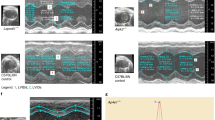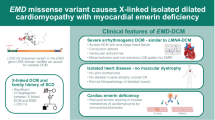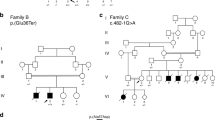Abstract
Dystroglycanopathies are a genetically heterogeneous subset of congenital muscular dystrophies that exhibit autosomal recessive inheritance and are characterized by abnormal glycosylation of α-dystroglycan. In particular, POMT2 (protein O-mannosyltransferase-2) mutations have been identified in congenital muscular dystrophy patients with a wide range of clinical involvement, ranging from the severe muscle-eye-brain disease and Walker–Warburg syndrome to limb girdle muscular dystrophy without structural brain or ocular involvement. Cardiovascular disease is thought to be uncommon in congenital muscular dystrophy, with rare reports of cardiac involvement. We describe three brothers aged 21, 19, and 17 years with an apparently homozygous POMT2 mutation who all presented with congenital muscular dystrophy, intellectual disabilities, and distinct cardiac abnormalities. All three brothers were homozygous for a p.Tyr666Cys missense mutation in exon 19 of the POMT2 gene. On screening echocardiograms, all siblings demonstrated significant dilatation of the aortic root and depressed left ventricular systolic function and/or left ventricular wall motion abnormalities. Our report is the first to document an association between POMT2 mutations and aortopathy with concomitant depressed left ventricular systolic function. On the basis of our findings, we suggest patients with POMT2 gene mutations be screened not only for myocardial dysfunction but also for aortopathy. In addition, given the potential for progression of myocardial dysfunction and/or aortic dilatation, longitudinal surveillance imaging is recommended both for patients with disease as well as those that have normal baseline imaging.
Similar content being viewed by others
Log in or create a free account to read this content
Gain free access to this article, as well as selected content from this journal and more on nature.com
or
References
Yanagisawa A, Bouchet C, Van den Bergh PY et al: New POMT2 mutations causing congenital muscular dystrophy: identification of a founder mutation. Neurology 2007; 69: 1254–1260.
Messina S, Mora M, Pegoraro et al: POMT1 and POMT2 mutations in CMD patients: a multicentric Italian study. Neuromuscul Disord 2008; 18: 565–571.
van Reeuwijk J, Brunner HG, van Bokhoven H et al: Glyc-O-genetics of Walker-Warburg syndrome. Clin Genet 2005; 67: 281–289.
Willer T, Amselgruber W, Deutzmann R, Strahl S et al: Characterization of POMT2, a novel member of the PMT protein O- mannosyltransferase family specifically localized to the acrosome of mammalian spermatids. Glycobiology 2002; 12: 771–783.
Manya H, Chiba A, Yoshida A et al: Demonstration of mammalian protein O-mannosyltransferase activity: coexpression of POMT1 and POMT2 required for enzymatic activity. Proc Natl Acad Sci USA 2004; 101: 500–505.
Godfrey C, Clement E, Mein et al: Refining genotype phenotype correlations in muscular dystrophies with defective glycosylation of dystroglycan. Brain 2007; 130: 2725–2735.
Prados B, Pena A, Cotarelo RP, Valero MC, Cruces J : Expression of the murine Pomt1 gene in both the developing brain and adult muscle tissues and its relationship with clinical aspects of Walker-Warburg syndrome. Am J Pathol 2007; 170: 1659–1668.
Finsterer J, Ramaciotti C, Wang CH et al: Cardiac findings in congenital muscular dystrophies. Pediatrics 2010; 126: 538–545.
Lefeber D, Schönberger J, Morava E, Guillard M, Huyben K, Verrijp K et al: Deficiency of Dol-P-Man synthase subunit DPM3 bridges the congenital disorders of glycosylation with the dystroglycanopathies. Am J Hum Genet 2009; 85: 76–86.
Hara Y, Balci-Hayta B, Yoshida-Moriguchi T, Kanagawa M et al: A dystroglycan mutation associated with limb girdle muscular dystrophy. N Engl J Med 2011; 364: 939–946.
van Reeuwijk J, Janssen M, van den Elzen C et al: POMT2 mutations cause alpha-dystroglycan hypoglycosylation and Walker-Warburg syndrome. J Med Genet 2005; 42: 907–912.
Murakami T, Hayashi YK, Noguchi et al: Fukutin gene mutations cause dilated cardiomyopathy with minimal muscle weakness. Ann Neurol 2006; 60: 597–602.
Nakanishi T, Sakauchi M, Kaneda Y et al: Cardiac involvement in Fukuyama-type congenital muscular dystrophy. Pediatrics 2006; 117: e1187–e1192.
Hiratzka LF, Bakris GL, Beckman et al: ACCF/AHA/AATS/ACR/ASA/SCA/SCAI/SIR/STS/SVM Guidelines for the diagnosis and management of patients with thoracic aortic disease. A Report of the American College of Cardiology Foundation/American Heart Association Task Force on Practice Guidelines, American Association for Thoracic Surgery, American College of Radiology, American Stroke Association, Society of Cardiovascular Anesthesiologists, Society for Cardiovascular Angiography and Interventions, Society of Interventional Radiology, Society of Thoracic Surgeons, and Society for Vascular Medicine. J Am Coll Cardiol 2010; 55: e27–e129.
Author information
Authors and Affiliations
Corresponding author
Rights and permissions
About this article
Cite this article
Martinez, H., Craigen, W., Ummat, M. et al. Novel cardiovascular findings in association with a POMT2 mutation: three siblings with α-dystroglycanopathy. Eur J Hum Genet 22, 486–491 (2014). https://doi.org/10.1038/ejhg.2013.165
Received:
Revised:
Accepted:
Published:
Issue date:
DOI: https://doi.org/10.1038/ejhg.2013.165
Keywords
This article is cited by
-
Cardiac complications of congenital disorders of glycosylation (CDG): a systematic review of the literature
Journal of Inherited Metabolic Disease (2017)



